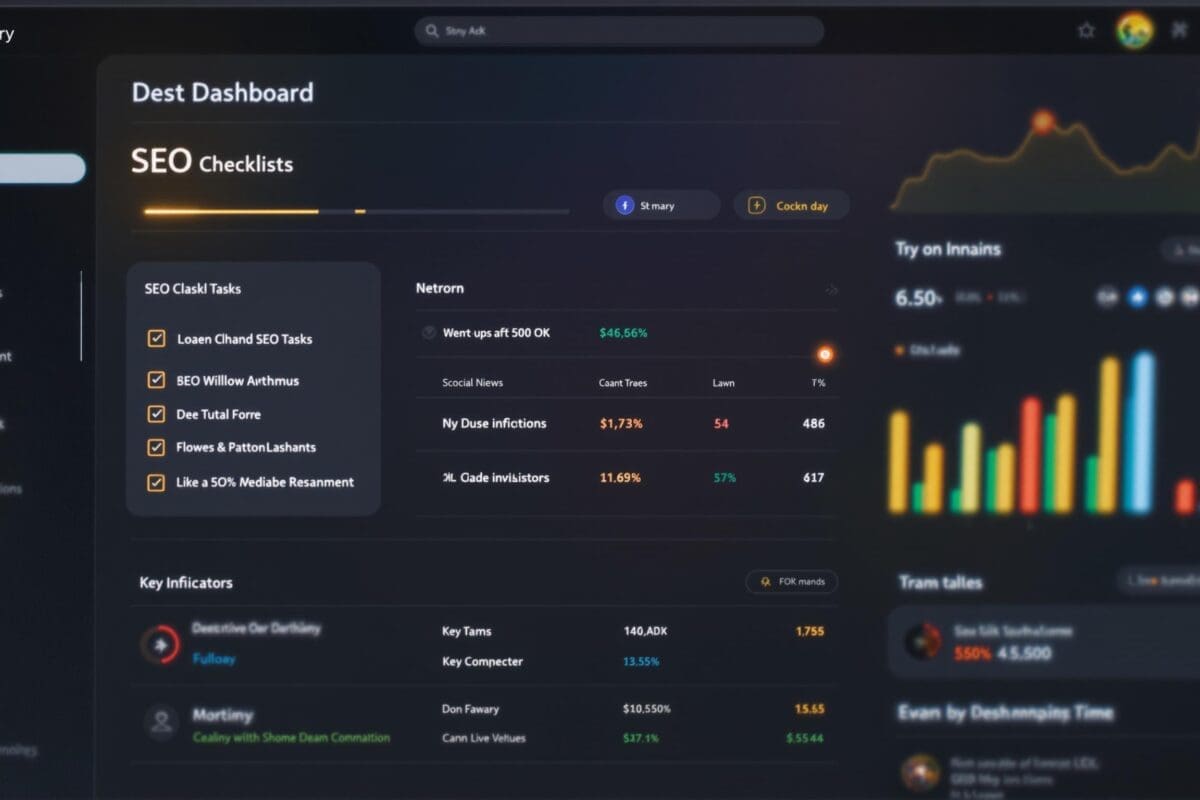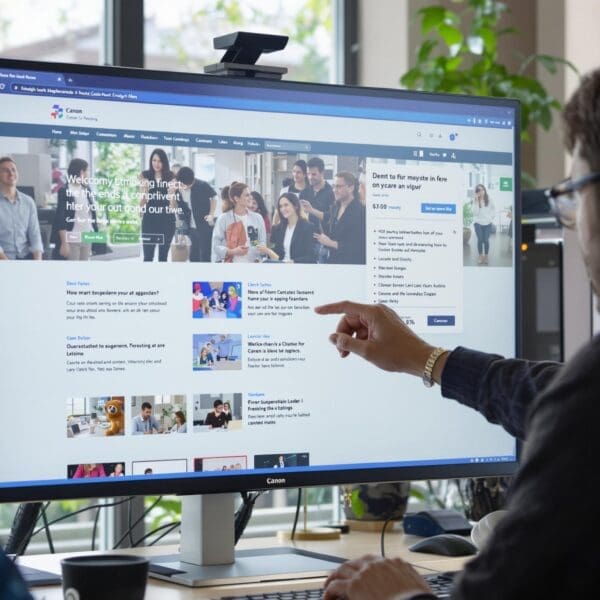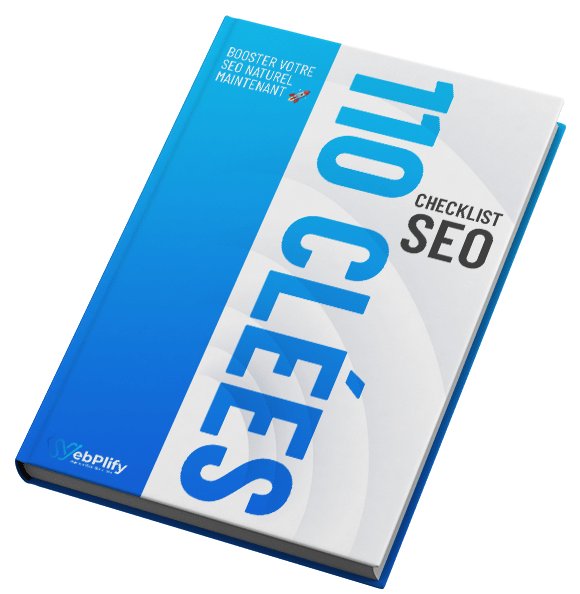✅ In a nutshell: 6 essential technical elements to optimize to improve your SEO
Loading speed: A fast site reduces the bounce rate and improves your Google ranking.
Mobile compatibility: With 48% of Quebec users on mobile, responsive design is crucial.
Meta tags: Well-written titles and descriptions boost visibility and click-through rate (CTR).
HTTPS security: an SSL certificate inspires confidence and is taken into account in indexing.
404 errors: Fix broken links and redirect deleted pages to avoid losing traffic.
Structure and data: Clean URLs, an up-to-date XML sitemap and structured data improve indexing and enhanced visibility in Google.
Get your technical SEO audit now
Is your website struggling to climb the search results rankings despite quality content? Technical SEO, the invisible foundation of search engine optimization, is often the weak link in digital strategies. This article details an operational checklist for optimizing your site’s foundations: loading speed, mobile compatibility, meta tags and HTTPS security. Discover how to turn your technical audit into a concrete lever for improving your visibility and user experience, with recommendations tailored to the specificities of the Quebec market.
Table of contents
ToggleLoading speed
Loading speed has a direct impact on user experience and search engine ranking. According to recent data, optimal response times reduce bounce rates by 40%. Free tools such as PageSpeed Insights enable you to measure performance and prioritize corrections.
Technical optimization includes image compression, CSS/JavaScript file minification and the use of CDNs. These methods reduce Time to Interactive while preserving visual quality, particularly crucial for Quebec sites targeting mobile devices.
Mobile-friendly
Responsive design is an essential part of a mobile-first strategy, as Google gives priority to indexing the mobile version of sites. Technical verification involves analyzing viewports and adjusting media queries to guarantee display on all screens. Multi-device testing avoids frequent rendering errors.
Adapting to Quebecois usage requires particular attention to tactile interaction and response times. Nearly half of local users navigate mainly via mobile, which requires simplified menus and buttons adapted to fingertip manipulation.
Meta tags
The title and description tags determine the click-through rate and the interpretation of content by search engines. A maximum 60-character title tag integrates the main keyword while remaining legible. The meta description, limited to 155 characters, should summarize the propositional value of the page.
Common errors include duplicate titles and generic descriptions. The use of canonical tags and a quarterly review of metadata help maintain technical consistency, which is important for multilingual sites in Quebec.
HTTPS security
The HTTPS protocol is an important signal of trust for users and search engines alike. Its implementation improves ranking while securing data exchanges. Migration from HTTP requires rigorous 301 redirection to preserve existing SEO.
Quebec companies prefer EV or OV SSL certificates to reinforce their local credibility. Regional hosting providers like WHC offer turnkey solutions including automatic certificate renewal, as detailed in our White Hat SEO guide.
404 error correction
Broken links hinder search engine optimization and impair the user experience. Detection is carried out via Google Search Console or automated scanners, with increased vigilance after content updates. A personalized 404 page helps to retain visitors while offering alternatives.
301 redirects are essential for perennially relocated URLs, while a strategy of updated internal links prevents future errors. For deleted products, a redirect to similar items preserves commercial potential, as demonstrated by Quebec e-commerce best practices.
URL structure
A clear URL architecture makes it easier for search engines to crawl your site, and improves readability. Use hyphens as separators and a hierarchy that reflects the content, avoiding unnecessary parameters. This approach fits perfectly into a coherent semantic structure.
For the Quebec market, retain accents in URLs, but limit their length to 60 characters. This adaptation preserves linguistic relevance without compromising SEO, with translated slugs for bilingual versions.
XML Sitemap
The XML sitemap guides the indexing of strategic content. As specified in the Google Search Central documentation, it prioritizes key pages while excluding obsolete or low-value-added URLs.
Static sites require monthly maintenance, with immediate updates after content is added. CMS plugins automate this task while generating separate indexes for language versions.
robots.txt file
The robots.txt file regulates crawler access to site resources to optimize the exploration budget. Proper configuration blocks non-essential directories such as temporary files or administration pages, thus conserving server resources.
Multilingual Quebec companies need to segment directives by language, specifying separate rules for the English and French versions. This approach avoids indexing conflicts while respecting local language preferences.
Structured data (Schema Markup)
The implementation of structured schemas improves the visibility of enriched extracts in search results. Article, LocalBusiness and Product types can display contextual information such as schedules or reviews, increasing click-through rates by an average of 30%.
For Quebec-based SMEs, contact information tagging must include a physical address that complies with local postal standards. For example, a Montreal restaurant could display its regional specialties and seasonal opening times directly in the SERPs.
Image optimization
The choice of image format has a direct impact on loading speed and visual quality. WebP and AVIF formats offer optimal compression, reducing file size by up to 30% with no perceptible alteration. According to a Statista study, this optimization is one of the most decisive technical practices for SEO.
Descriptive alt tags and structured metadata improve accessibility while enhancing SEO relevance. A complete optimization strategy incorporates intelligent cropping and lazy loading, as detailed in our guide to best technical practices for Quebec businesses.
Comparison
Technical optimization priorities vary according to company size and resources. To measure the impact of these optimizations, track SEO key performance indicators. Quebec SMEs will focus on quick fixes (meta tags, mobile speed), while larger structures will invest in comprehensive audits and scalable architectures. Our article on the 6 key steps to optimizing your SEO details this gradual approach.
| Technical element | SEO impact | Complexity of implementation |
|---|---|---|
| Loading speed | High (53% abandonment after 3s) | Medium (multi-sector optimization) |
| Responsive design | Critical (48% mobile use in Quebec) | Average (multi-screen adaptation) |
| Title/meta tags | Direct (+20% average CTR) | Low (targeted optimization) |
| HTTPS certificate | Mandatory (indexing bonus) | Average (technical migration) |
| 404 management | Preventive (crawl budget savings) | Low (automated tools) |
| URL architecture | Structural (better exploration) | Weak (best practices) |
| Dynamic Sitemap | Basic (indexing coverage) | Weak (automatic generation) |
| Structured data | Differentiating (+30% visibility) | High (technical expertise) |
Prioritize SEO actions according to your technical maturity and available resources: For a global view of technical SEO best practices,
- Technical site optimization: light audits and quick fixes for SMEs, structural overhauls for large companies
- Loading speed: image compression and caching as a priority, advanced server solutions for complex structures
- Mobile-friendly: responsive design essential for all, dedicated touch budgets for large organizations
- Technical website audit: free tools sufficient for small structures, in-depth analyses necessary for high-traffic sites
Technical website optimization rests on three pillars: loading speed, mobile compatibility and HTTPS security. To maximize your visibility in search engines, start with a detailed audit of the key elements addressed. By prioritizing these corrections, you’ll position your site sustainably at the top of the results, while offering an irreproachable user experience.
Frequently asked questions about Technical SEO (FAQ)
What tools are needed for a technical SEO audit?
To carry out a technical SEO audit, several tools are available, each offering specific functionalities. Among the most widely used are crawlers such as Screaming Frog SEO Spider, performance analysis tools such as Google PageSpeed Insights, and comprehensive solutions such as Semrush Site Audit. These tools help identify technical problems and improve overall site performance.
Other tools include Google Search Console to monitor indexing, GTMetrix to measure speed, and browser extensions like Yoast SEO. The combined use of these tools offers a complete overview, enabling effective site optimization for better SEO.
What are the steps in a technical SEO audit?
A technical SEO audit includes several key steps to improve a website’s ranking. It starts with checking meta tags and page structure, ensuring that they are optimized for the target keywords. Optimizing the site’s tree structure is also essential to facilitate navigation for users and crawlers.
Analysis of the site’s technical structure, verification of indexing by Google, and regular performance monitoring are equally important. These steps make it possible to identify and correct technical problems, thus improving the site’s visibility and user experience.
What are the KPIs for measuring the impact of technical SEO?
KPIs for measuring the impact of technical SEO include various performance indicators. Site speed, measured by page load time and server response time, is crucial. Crawlability and indexing, with the number of indexed pages and crawl errors, are also essential KPIs.
Other important KPIs includemobile adaptability, site structure and use of structured data, as well as security with the switch to HTTPS. Organic traffic, click-through rate (CTR) and user engagement (bounce rate, session duration) round out these metrics, enabling the effectiveness of technical optimizations to be assessed.
Who needs a technical SEO audit?
A technical SEO audit is essential for any person or company wishing to improve the performance of their website. Get your SEO audit now with our tools by clicking here. This includes those who want to ensure that their site is correctly crawled and indexed by search engines, or who are looking to identify and correct technical errors that could be harming their rankings.
This audit is also beneficial for those wishing to optimize the speed and user-friendliness of their site, or to improve their SEO strategy. In short, any person or company wishing to maximize the visibility and performance of their website should consider a technical SEO audit.















